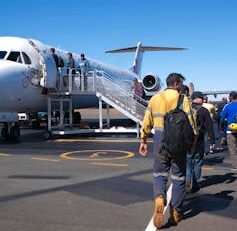
Western Europe’s oldest human face discovered in Spain
The research team at the Atapuerca archaeological sites in Burgos, Spain, has just broken its own record by discovering, for the third time, the oldest human in Western Europe.
The team did so for the first time in 1994, when they unearthed the remains of a new human species, which they named Homo antecessor, at the TD6 level of the Gran Dolina site. These fossils, dated to around 900,000 years ago, challenged the previous notion that the earliest human presence in Western Europe was no older than half a million years.
Beyond the numbers, Homo antecessor also had a surprisingly modern-looking face. The Gran Dolina hominids exhibited a flat face that was, despite their antiquity, very similar to that of our own species, Homo sapiens. In a beautiful scientific paradox, Homo antecessor showed us the oldest face of modern humanity.
In 2007, in the Sima del Elefante (Pit of the Elephant), a site no more than 300 metres from the Gran Dolina, the oldest human in Europe was found once again. This time it was a human jawbone, found in level TE9, dated to approximately 1.2 million years ago.
The new jawbone, catalogued as ATE9-1, had a number of primitive features in the anterior part of the chin region and symphysis, which is logical given its great age. However, on the inner surface of the symphysis, the bone was vertical and more slender than expected, especially in comparison with other contemporary hominids.
Even so, the fossil was too fragmentary to be assigned to any species, or even to confirm or rule out its belonging to Homo antecessor. ATE9-1 was therefore classified as Homo sp., a term which recognised its belonging to the genus Homo, but also accepted our inability to refine it further with the evidence available at the time.
Never two without three
In 2022, against all odds, the excavation team at the Sima del Elefante site discovered the left half of a hominid face from level TE7. This fossil was found two and a half metres below the level where the ATE9-1 jawbone had been found, which meant that it was even older.
Over the following two years, our interdisciplinary and multi-institutional team – with substantial support from the Catalan Institute of Human Paleoecology and Social Evolution (IPHES) and the National Centre for the Investigation of Human Evolution (CENIEH) – devoted itself to studying and restoring the fossil.
We used both classical methods and advanced imaging techniques, including X-ray microtomography, which allowed us to visualise the interior of the fossils and manipulate them digitally without having to touch them. This meant we were able to reconstruct the puzzle, and compare it with other specimens without having to access the original fossils, which are scattered all over the world.
The new fossil was nicknamed “Pink”, an allusion to Pink Floyd’s album The Dark Side of the Moon, which translates into Spanish as “La cara oculta de la luna” – “cara oculta” means “hidden face”. I must also admit that the research team adopted this name in recognition of our colleague Rosa Huguet, researcher at IPHES-CERCA, coordinator of the work at the Sima del Elefante site, and the lead author of the study, published in the journal Nature – “Rosa” is Spanish for “pink”.
Archaeological excavation at level TE7 of the Sima del Elefante site (Sierra de Atapuerca, Burgos).
Maria D. Guillén / IPHES-CERCA.
Pink’s rugged face
The main conclusion of study just published in Nature is that Pink does not belong to the species Homo antecessor. The new fossil presents clear differences in the facial area, which is more robust and projected forward, in clear contrast with the slender face of the Gran Dolina hominids. Furthermore, we believe that in Pink the nose area was flattened and sunken, similar to that of the species Homo erectus and other non-human primates.
However, ATE7-1, as Pink was officially catalogued, also has some characteristics that do not allow us to classify it directly as H. erectus, such as its comparatively narrower and shorter face shape.
In view of these features, the Atapuerca team has decided to classify Pink as “Homo affinis erectus” (abbreviated as H. aff. erectus). This term recognises its similarities to H. erectus, but leaves open the possibility that it may belong to another species altogether.
The value of Atapuerca
This discovery reveals the existence of a human species that, until now, had not been documented in Europe. The European Pleistocene family photo album previously included H. antecessor, Neanderthals and modern humans. We can now add the slightly blurred photograph of a new relative, in the hope that further studies and more fossils will bring it into sharper focus.
The discovery also leads us to reflect on the research that can and should be done. There is no doubt that Atapuerca is an exceptionally rich archaeological and palaeontological site. For years now, the caves in Burgos have shown their ability to capture evidence, however scarce and fragmentary, of each and every one of the periods in which Europe was inhabited.
While luck does have a part to play in Atapuerca it is, above all else, tenacity and commitment that have made it such a significant area. Nothing is left to chance, and the site is proof that when you take science seriously, it yields results. In order for research in Atapuerca to prosper, it has taken time and constant dedication, both from the researchers and from the institutions that support it and ensure its sustainability.
Let us hope that this achievement will give us the encouragement we need to continue to look towards new horizons. Läs mer…







